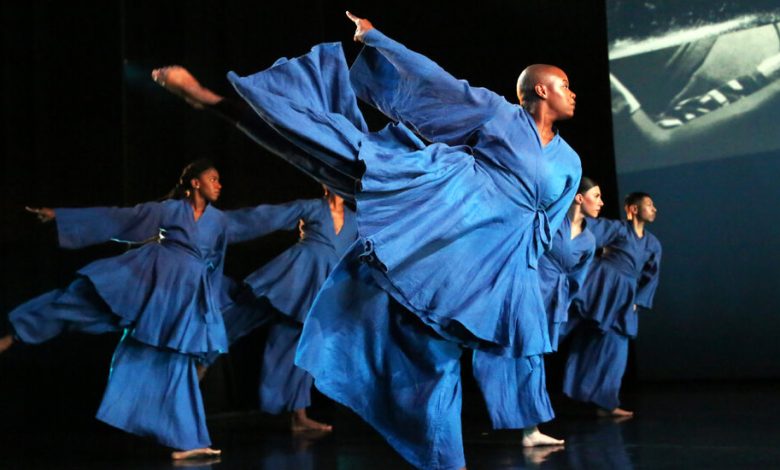Review: A Dance Searching for Harmony in an Unequal World

“The Equality of Night and Day,” a New York premiere by the choreographer Ronald K. Brown and his company, Evidence, essentially starts out mid thought. A voice says, “And finally.”
It’s so no-nonsense that it practically sounds like a complete sentence. Spoken by the activist Angela Davis in a tone verging on weariness, the “and finally” urges the crowd — at least the one you imagine standing before her — to think about the larger picture, as she talks about issues that ail the United States, like “the assault against affirmative action” and “the increasing conservatism.”
The dancer Joyce Edwards, a silky powerhouse full of drama whether seemingly motionless or rippling her body with fervor, is poised center stage: She bends forward and rises back up with crossed wrists until her arms lift and bloom out like glorious wings. The lighting evokes the faded radiance of a sunset. As the other dancers gather around her, she clasps her hands, and we hear Davis ask that the people before her “think very deeply about what you can do to make a difference.”
Davis’s speeches are heard throughout this 2022 work, performed at the Joyce Theater, but better is its sparkling score by the jazz pianist Jason Moran. The music starts out spare and contained, but gradually builds with blistering, tinkering speed to get at, sonically, the urgency of not just one, but multiple generations that have faced oppression.
The dancers are dressed in vivid-blue wide-legged pants with wrap tops, which extend past the hips, by Omotayo Wunmi Olaiya. Wearing her arresting costumes, which serve to shield the body in somber moments of pathos or to expand and articulate it in action, the performers could almost be mistaken for healers.
But as their movement makes connections with Davis’s words, you sense that they are part of the world, sufferers of the everyday, especially the men.At one point, Davis speaks about “the figure of the criminal”; later, the male dancers cover their faces and scream.
This is not the usual way emotion is displayed in a dance by Brown, but there is something inevitable about such a release — after it, Moran’s music dips into a faster, deeper groove, and “The Equality of Night and Day” flips on itself, finding, for a short time, a lighter pulse. The title itself is evasive: Brown came up with it after listening to the John Coltrane song “Equinox,” he told me during an interview a few years ago, and started to think about what the word meant. What happens when the day and night are equal?
Finding balance and fairness in the world seems impossible, yet Brown maintains his usual approach: He stays on the side of love, of truth and of peace. In “Night and Day,” you get the feeling that what he might be done with is patience.
As the dancers flex their hands and press their arms out or flip their palms up with feeling, they move as a group in a meditative plea, like Davis says, to get the world back on track — or, if that’s too hard, to convince one person at a time that injustice has no place in it.
Slowly, methodically, the performers walk in lines along the perimeter of the stage as others take turns in the center. This potent dance undulates; it has vibrations.
Throughout, images documenting protests over time, curated by Deborah Willis, are shown at the back of the stage. (The scenography is by Tsubasa Kamei.) They feel unnecessary; it’s like having a voice-over when you already have a voice-over. The words could be edited down, too, distilled or stripped away completely to let the music and dance speak for themselves. They are enough. In “The Equality of Night and Day,” Moran’s music and Brown’s choreography provide the power — and perhaps the tools to start thinking about how to create a better society, if only society would watch and listen a little harder.
When Moran’s music expands into an uplifting cascade of notes, one tumbling into the next, the beat picks up and the dancers take to the air, but “Night and Day” ends on a pensive, quiet note as the performers remove their tops, drop them to the floor and congregate in a corner of the stage. One by one, they touch, hands on shoulders. It’s a snapshot of a dance company, yes, but also of any bonded community.
Brown, who knows how to heat up a theater, bookends “Night and Day” with two of his most enlivening works, in which the vivid drive of his choreography — a tapestry of modern and African dance and Afro-Cuban forms — has a way of spilling past the stage and into the crowd. The program begins with “Open Door” (2015), with live music by the Afro Latin Jazz Ensemble, and ends with “Grace” (1999/2003).
Both were created for Alvin Ailey American Dance Theater; both are, in different ways, life affirming with, here, standout performances by Shaylin D. Watson and Isaiah K. Harvey in “Open Door” and Shayla Alayre Caldwell in “Grace.” In each, Brown, full of spirituality and generosity, elevates dance to a higher ground. But perhaps the best part of the night was when Brown, with a gorgeous grin, came out for a bow with Arcell Cabuag, the company’s associate artistic director. In 2021, Brown had a stroke, but here, as his dancers let loose, he swayed along with them, his torso contained but also, undeniably, feeling the beat.
Ronald K. Brown/Evidence
Through Jan. 22 at the Joyce Theater, Manhattan; joyce.org.
